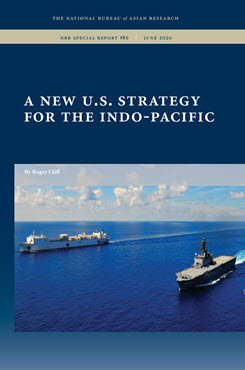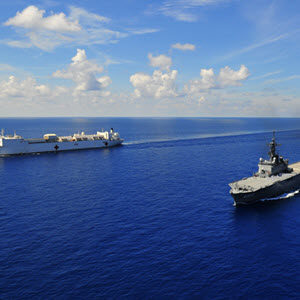NBR Special Report no. 86
A New U.S. Strategy for the Indo-Pacific
This report describes U.S. interests in the Indo-Pacific, challenges and opportunities the United States will likely face in the region over the next decade, the resources available to the United States for protecting and advancing its interests, and a recommended strategy for doing so.
EXECUTIVE SUMMARY
MAIN ARGUMENT
The Indo-Pacific is a region of critical importance to the U.S., but one in which it is likely to face major challenges in coming years. China will be both the dominant economy and the dominant military power (other than the U.S.) in the region and will continue its efforts to take control over Taiwan, the South China Sea, and the Senkaku Islands. Beijing will also continue to infiltrate and subvert the political systems of countries in the Indo-Pacific and elsewhere in the world. Meanwhile, North Korea will continue to increase its capability to attack the U.S. with nuclear weapons, and state failure in North Korea is a possibility over the next decade. Other adverse events could occur as well, including interstate conflict, new internal conflicts, democracies becoming autocracies, and Islamist regimes coming to power. In addition, unusually hot weather and floods will become more frequent as a result of global climate change, and the Indo-Pacific will be a major source of environmental pollution and greenhouse gas emissions. At the same time, the Indo-Pacific presents major strategic opportunities for the U.S., which still enjoys significant strengths. The U.S. possesses more human capital than any country in the world, has the world’s best technological capabilities, and has by far the world’s most capable military. Perhaps its greatest asset in the region, however, is its democratic allies, particularly Japan, South Korea, and Australia. As a result, U.S. Indo-Pacific strategy should focus on strengthening ties with the democracies of the region and making those democracies stronger and more secure.
POLICY IMPLICATIONS
To protect and advance its interests in the Indo-Pacific, the U.S. should adopt a strategy toward the region that includes the following main elements:
- Strengthening U.S. relations with democracies
- Promoting the economic growth of democracies
- Strengthening the defense capabilities of democracies
- Helping end internal conflicts in democracies
- Helping strengthen democratic institutions in all Indo-Pacific countries
- Reducing external military threats to democracies
- Strengthening the capabilities of the U.S. to defend democracies
- Promoting democracy and human rights in nondemocratic countries
- Continuing to provide humanitarian assistance and disaster relief
- Providing economic assistance to countries during crises
- Working with all Indo-Pacific nations to reduce pollution and greenhouse gas emissions
Table of Contents
Chapter 1
Introduction
Chapter 2
Long-Term Regional Trends
Chapter 3
The Strategies of Key Regional Actors
Chapter 4
Potential Major Events
Chapter 5
Resources Available to the United States for an Indo-Pacific Strategy
Chapter 6
A New U.S. Strategy for the Indo-Pacific
Roger Cliff conducts research on international relations in the Indo-Pacific. He has worked for the Center for Naval Analyses, Atlantic Council, Project 2049 Institute, RAND Corporation, and Office of the Secretary of Defense. He holds a PhD in international relations from Princeton University, an MA in Chinese studies from the University of California San Diego, and a BS in physics from Harvey Mudd College.



 The Future of U.S. Strategy in the Indo-Pacific
The Future of U.S. Strategy in the Indo-Pacific